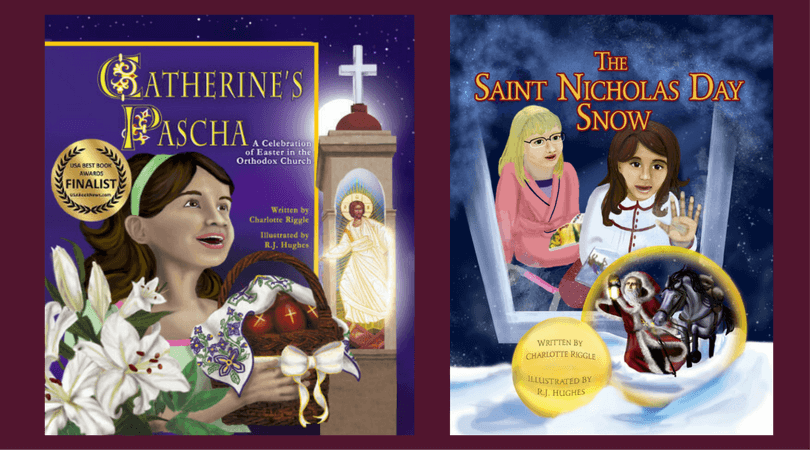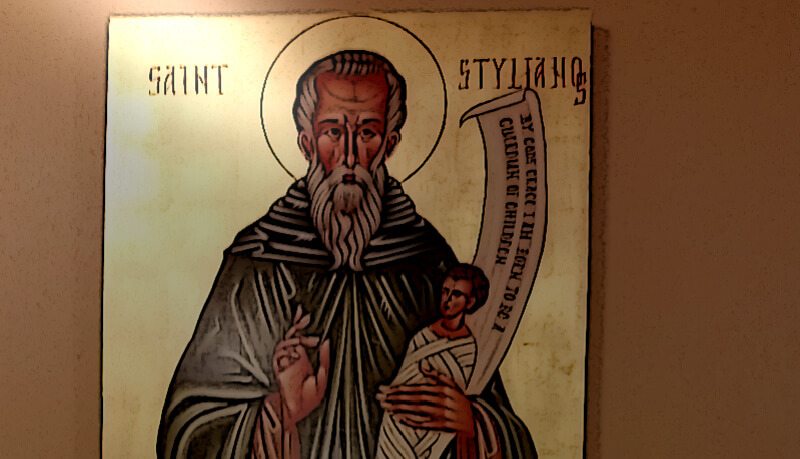St. Stylianos was the child of wealthy parents in Paphlagonia, a region in what is now Turkey. No one is quite sure when he lived; it may have been the fourth century, or the sixth, or some time in between. But, like so many other saints, he had no use for the wealth he inherited from his parents. When they died, he gave it all away, and retired to a monastery, to seek the good things of heaven rather than of earth.
At some point, he chose to leave the monastery and take up life in a hermit’s cave. According to some stories, the other monks didn’t much care for him, and out of jealousy or spite, they drove him out. Or he found it so unbearable he chose to leave. Whatever happened, he decided to go live alone in a cave in the wilderness. There, he would be able to devote himself to prayer and fasting.
But he didn’t withdraw completely. He would leave his cave and spend time among the people. It seems that, for him, it wasn’t enough to pray and fast. He wanted to add works of kindness and goodness to his ascetic labors. So it became his custom to go out to serve. Then he would return to his cave to rest and pray.
Joy and healing
One night, as he asked God to grant him guidance for the following day, he felt the presence of the Holy Spirit consuming him, filling him with peace and joy. And the next day, as he visited people, to teach them and comfort them, he laid his hand on a child who was ill. That was something he’d never done before. And at his touch, the child was healed.
At that point, his life changed. People came to him for healing. And parents brought their children who were sick and afflicted. The sick recovered, by the power of God, by his prayers, and, he told them, by their own faith.
And the children! They loved the hermit Stylianos. He wasn’t like the other hermits, grave and severe. He always, always smiled. And he received everyone with joy. Even, especially, the mothers with their flocks of noisy, busy children.
Daycare at the hermitage
Sometimes the mothers told St. Stylianos that they were overwhelmed. They had so much to do, and it didn’t seem possible to do it all and care for their children at the same time. He began to tell the mothers that they could leave their children with him for the day. He would take care of the children while they took care of their other tasks. They could come back and get their children whenever they were done.
Of course he refused to allow the mothers to pay him for taking care of their children, any more than he would accept payment for healing them when they were sick. The joy and peace that God had given him was all the pay he ever wanted, and all that he would accept.
Before long, he had to find more space, and recruit helpers from among the other hermits. And there were people, even then, who saw the possibility of profit in what he was doing. They came to him and told him how he could use his talents to get rich (giving them a cut of the profits, of course). He would smile at them, and tell them he was already rich. He had everything he needed, and joy besides.
In his icons, St. Stylianos is always shown holding a baby, sometimes two. And he holds a scroll that says, “By God’s grace, I was born to be a guardian of children.”
Troparion to St. Stylianos
As a worker of God-given wonders, and a protector of the youth and infants, O Stylianos, our Father and healer of Christ, grant children to barren mothers, and ever cover newborn babes, for to you was richly granted grace from God, as you struggled for Him in asceticism as an angel.
Read More
St. Irene and the Apples of Paradise: St. Irene’s story starts out like a fairy tale. But, though she was beautiful, she wasn’t interested in marrying the prince.
A Child Who Never Sleeps: Two of my children struggled to sleep, and now my grandchild has the same struggle. Here’s some of what I learned. (Adding prayers to St. Stylianos would not go amiss!)
Leave Me Alone! A Review: This Caldecott honor book about a grandmother who just wants to be left alone so she can do her knitting will surely become a classic.
Buy the Books!

These delightfully diverse books provide disability representation (Elizabeth, one of the main characters, is an ambulatory wheelchair user). They also give Orthodox Christian children the rare opportunity to see themselves in books, and children who are not Orthodox the chance to see cultural practices they may not be familiar with.
Catherine’s Pascha
FINALIST IN THE 2015 USA BEST BOOK AWARDS
Catherine doesn’t like vegetables. She doesn’t like naps. She doesn’t like it when her mom combs her hair. She loves hot dogs, chocolate cake, and her best friend, Elizabeth. Most of all, she loves Pascha! Pascha, the Orthodox Christian Easter, is celebrated in the middle of the night, with processions and candles and bells and singing. And Catherine insists that she’s not a bit sleepy.
Celebrate the joy of Pascha through the magic of a book: Catherine’s Pascha. Available on Amazon, Bookshop.org, and my webstore.
The Saint Nicholas Day Snow
Shoes or stockings? Horse or sleigh? Does St. Nicholas visit on December 6 or on Christmas Eve? Will a little girl’s prayer be answered? When Elizabeth has to stay at Catherine’s house, she’s worried about her grandmother, and worried that St. Nicholas won’t find her. The grownups, though, are worried about snow.
Celebrate the wonder of St. Nicholas Day through the magic of a book: The Saint Nicholas Day Snow. Available on Amazon, Bookshop.org, or my webstore.




Thank you!!